
Wassily Wassilyevich Kandinsky was a Russian painter and art theorist. Kandinsky is generally credited as the pioneer of abstract art. Born in Moscow, Kandinsky spent his childhood in Odessa, where he graduated at Grekov Odessa Art school. He enrolled at the University of Moscow, studying law and economics. Successful in his profession—he was offered a professorship at the University of Dorpat —Kandinsky began painting studies at the age of 30.

Paul Klee was a Swiss-born German artist. His highly individual style was influenced by movements in art that included expressionism, cubism, and surrealism. Klee was a natural draftsman who experimented with and eventually deeply explored color theory, writing about it extensively; his lectures Writings on Form and Design Theory, published in English as the Paul Klee Notebooks, are held to be as important for modern art as Leonardo da Vinci's A Treatise on Painting for the Renaissance. He and his colleague, Russian painter Wassily Kandinsky, both taught at the Bauhaus school of art, design and architecture in Germany. His works reflect his dry humor and his sometimes childlike perspective, his personal moods and beliefs, and his musicality.

Barnett Newman was an American artist. He is seen as one of the major figures in abstract expressionism and one of the foremost of the color field painters. His paintings are existential in tone and content, explicitly composed with the intention of communicating a sense of locality, presence, and contingency.

Robert Delaunay was a French artist who, with his wife Sonia Delaunay and others, co-founded the Orphism art movement, noted for its use of strong colours and geometric shapes. His later works were more abstract. His key influence related to bold use of colour and a clear love of experimentation with both depth and tone.

Raymond Georges Yves Tanguy, known as just Yves Tanguy, was a French surrealist painter.

Alice Neel was an American visual artist, who was known for her portraits depicting friends, family, lovers, poets, artists, and strangers. Her paintings have an expressionistic use of line and color, psychological acumen, and emotional intensity. Her work depicts women through a female gaze lens, illustrating them as being consciously aware of the objectification by men and the demoralising effects of the male gaze. Her work contradicts and challenges the traditional and objectified nude depictions of women by her male predecessors. Neel was called "one of the greatest portrait artists of the 20th century" by Barry Walker, curator of modern and contemporary art at the Museum of Fine Arts, Houston, which organized a retrospective of her work in 2010.
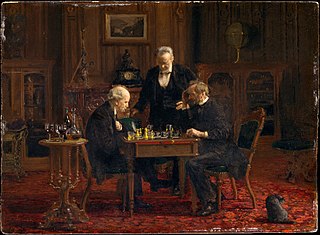
The Chess Players is an 1876 genre painting by Thomas Eakins, Goodrich catalogue #96. It is in the collection of the Metropolitan Museum of Art.

The Bride Stripped Bare by Her Bachelors, Even, most often called The Large Glass, is an artwork by Marcel Duchamp over 9 feet (2.7 m) tall, and freestanding. Duchamp worked on the piece from 1915 to 1923, creating two panes of glass with materials such as lead foil, fuse wire, and dust. It combines chance procedures, plotted perspective studies, and laborious craftsmanship. Duchamp's ideas for the Glass began in 1913, and he made numerous notes and studies, as well as preliminary works for the piece. The notes reflect the creation of unique rules of physics, and myth which describes the work.

The Hamburger Kunsthalle is the art museum of the Free and Hanseatic City of Hamburg, Germany. It is one of the largest art museums in the country. The museum consists of three connected buildings, dating from 1869, 1921 (Kuppelsaal) and 1997, located in the Altstadt district between the Hauptbahnhof and the two Alster lakes.
Gene Davis was an American Color Field painter known especially for his paintings of vertical stripes of color.

Jennifer Losch Bartlett is an American artist. She is known for paintings and prints that combine the system-based aesthetic of Conceptual art with the painterly approach of Neo-expressionism. Many of her pieces are executed on small, square, enamel-coated steel plates that are combined in grid formations to create very large works.

Edna Andrade was an American abstract artist. She was an early Op Artist.

Crucifixion Diptych — also known as Philadelphia Diptych, Calvary Diptych, Christ on the Cross with the Virgin and St. John, or The Crucifixion with the Virgin and Saint John the Evangelist Mourning — is a diptych by the Early Netherlandish artist Rogier van der Weyden, completed c. 1460, today in the Philadelphia Museum of Art. The panels are noted for their technical skill, visceral impact and for possessing a physicality and directness unusual for Netherlandish art of the time. The Philadelphia Museum of Art describes work as the "greatest Old Master painting in the Museum."
Ann Temkin is an American art curator, and currently the Marie-Josée and Henry Kravis Chief Curator of Painting and Sculpture at the Museum of Modern Art in New York.
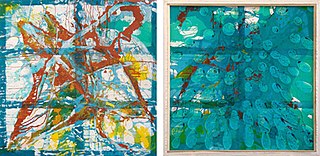
Dona Nelson is an American painter, best known for immersive, gestural, primarily abstract works employing unorthodox materials, processes and formats to disrupt conventional notions of painting and viewership. A 2014 New Yorker review observed, "Nelson gives notice that she will do anything, short of burning down her house to bully painting into freshly spluttering eloquence." Since 2002, long before it became a more common practice, Nelson has produced free-standing, double-sided paintings that create a more complex, conscious viewing experience. According to New York Times critic Roberta Smith, Nelson has dodged the burden of a "superficially consistent style," sustained by "an adventuresome emphasis on materials" and an athletic approach to process that builds on the work of Jackson Pollock. Writers in Art in America and Artforum credit her experimentation with influencing a younger generation of painters exploring unconventional techniques with renewed interest. Discussing one of Nelson's visceral, process-driven works, curator Klaus Kertess wrote, the paint-soaked "muslin is at once the tool, the medium, and the made."
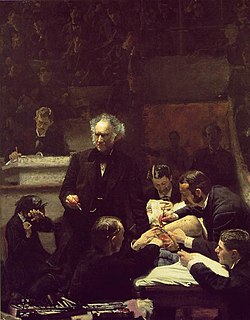
The conservation-restoration of Thomas Eakins' The Gross Clinic refers to the on-going conservation-restoration treatments of American painter Thomas Eakins' 1875 painting The Gross Clinic throughout the 20th and 21st centuries. These treatments are a testament to the changing methodologies undertaken in the field of paintings conservation.
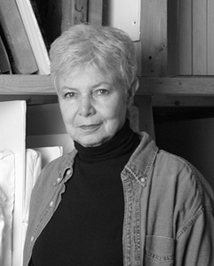
Merle Temkin is a New York City-based painter, sculptor and installation artist, known for vibrant, abstracted paintings based on her own enlarged fingerprint, and earlier site-specific, mirrored installations of the 1980s. Her work has often involved knitting-like processes of assemblage and re-assemblage, visual fragmentation and dislocation, and explorations of identity, the hand and body, and gender. In addition, critics have remarked on the play in her work between systematic experimentation and intuitive exploration. Her painted and sewn "Fingerprints" body of work has been noted for its "handmade" quality and "sheer formal beauty" in the Chicago Sun-Times and described elsewhere as an "intensely focused," obsessive joining of thread and paint with "the directness and desperation of marks on cave walls." Critic Dominique Nahas wrote "Temkin's labor-intensive cartography sutures the map of autobiography onto that of the universal in sharply revelatory ways." Her public sculptures have been recognized for their unexpected perceptual effects and encouragement of viewer participation. Temkin's work has been featured in publications including the New York Times, Artforum, ARTnews, New York Magazine, and the Washington Post. Her work belongs to the permanent collections of the Racine Art Museum, Museum of Arts and Design in New York, and Israel Museum, among others.

Dog Barking at the Moon is a painting by Spanish painter and sculptor Joan Miró. It was painted in 1926 in the town of Mont-roig del Camp, Catalonia. The painting was originally in the collection of Albert Eugene Gallatin before being bequeathed to the Philadelphia Museum of Art in 1952, where it remains.
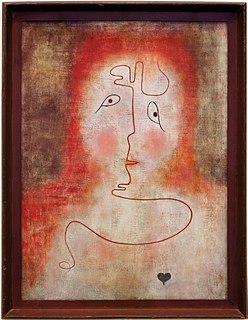
In the Magic Mirror is an abstract oil painting produced in 1934 by the Swiss-based German artist Paul Klee. It is now in the collection of the Art Institute of Chicago.

Ground Swell is a 1939 painting by American artist Edward Hopper which depicts four people on a heeling catboat in a light swell, looking at an ominous buoy. It was in the collection of the Corcoran Gallery of Art from 1943 until it was purchased by the National Gallery of Art in Washington, D.C. in 2014.


















